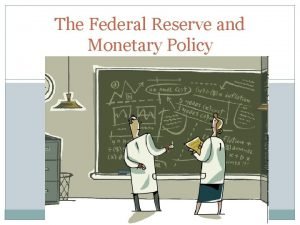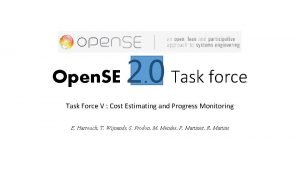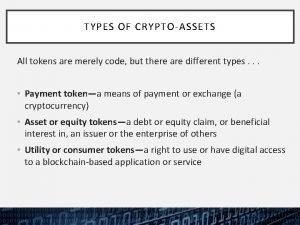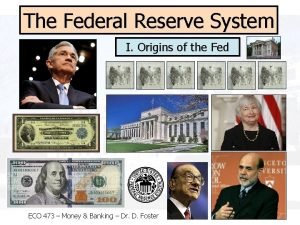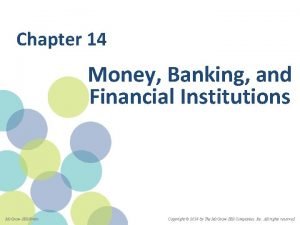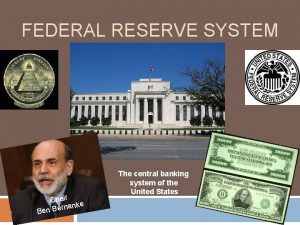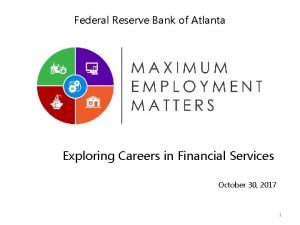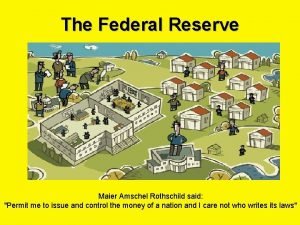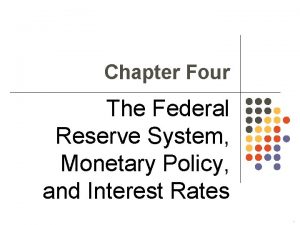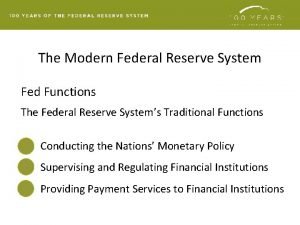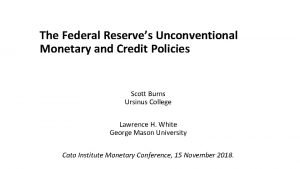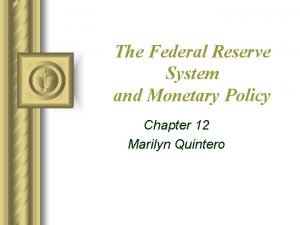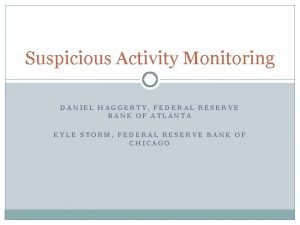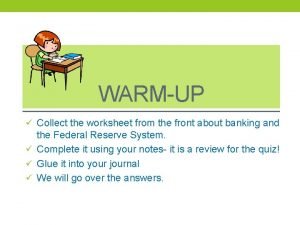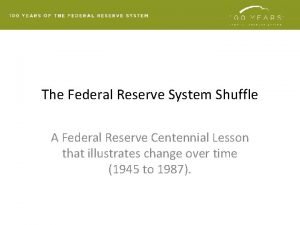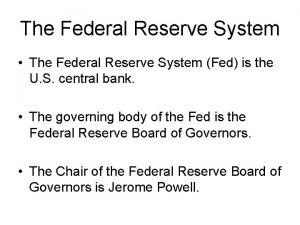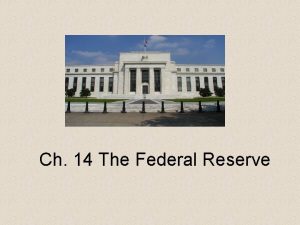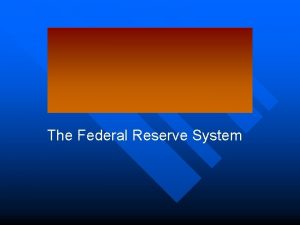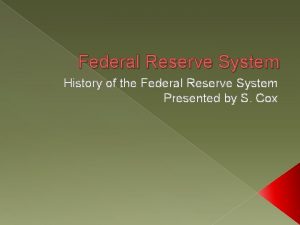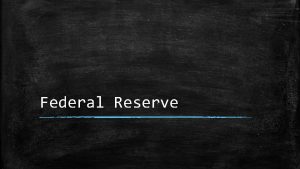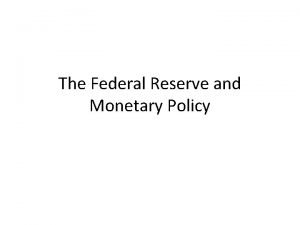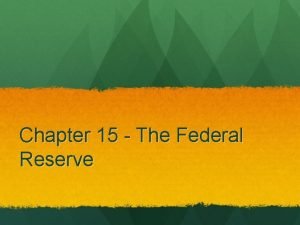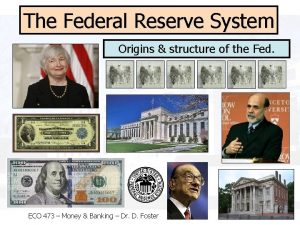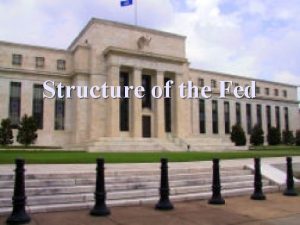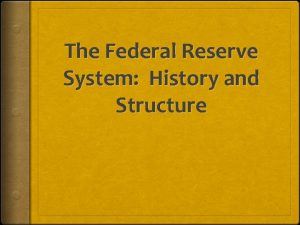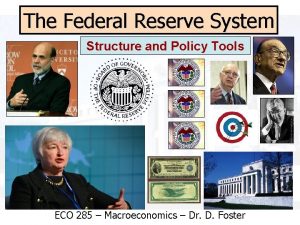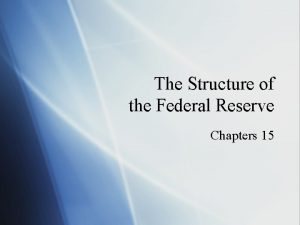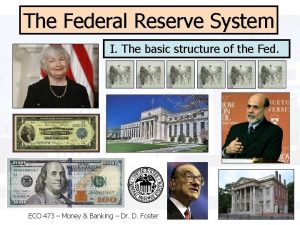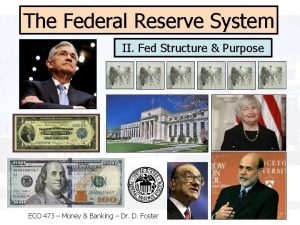STRUCTURE OF THE FEDERAL RESERVE The Federal Reserve



















- Slides: 19

STRUCTURE OF THE FEDERAL RESERVE

The Federal Reserve □ The Federal Reserve (Fed) serves as the nation’s central bank. u It is designed to oversee the banking system. u It regulates the quantity of money in the economy.

The Federal Reserve □ The Fed was created in 1914 after a series of bank failures convinced Congress that the U. S. needed a central bank to ensure the health of the nation’s banking system.

THE BOARD OF GOVERNORS □ Headquarters is in Wash. D. C. □ There are 7 members on the Board. □ They serve 14 year terms that are nonrenewable. □ They are appointed by the President with Senate approval.

□ The President also appoints the Chairman of the Board of Governors. He/she serves a 4 year term which can be renewed. □ The current Chairman is Ben S. Bernanke. □ He has served since 2006 and his term ends in 2020.

FEDERAL RESERVE BANKS □ There a total of 12 Federal Reserve districts. □ They monitor and report on economic and banking conditions in its district. □ Each district is made up of several states. □ Texas is in district 11. http: //www. federalreserve. gov/otherfrb. htm

The Federal Reserve System

MEMBER BANKS □ State and national banks use the FED for check clearing and reserve loans. □ The 4, 000 members banks contribute money to join and then own stock in the FED.

{FOMC} FEDERAL OPEN MARKET COMMITTEE □ Makes key decisions regarding interest rates. □ They meet about 8 times a year to discuss the cost of credit.

□ All 7 of the members of the Board of Governors of the FED sit on the committee, 5 of the 12 districts have bank Presidents sitting on the FOMC, and the President of the New York FED sits on the FOMC.

Three Primary Functions of the Fed □ □ □ Regulates banks to ensure they follow federal laws intended to promote safe and sound banking practices. Acts as a banker’s bank, making loans to banks and as a lender of last resort – does NOT make loans to individual citizens. Conducts monetary policy by controlling the money supply.

Changing the Discount Rate □ The discount rate is the interest rate the Fed charges banks for loans. u Increasing the discount rate decreases the money supply. u Decreasing the discount rate increases the money supply.

Banks and The Money Supply □ □ Reserves are deposits that banks have received but have not loaned out. In a fractional reserve banking system, banks hold a fraction of the money deposited as reserves and lend out the rest.

Money Creation When a bank makes a loan from its reserves, the money supply increases.

Money Creation □ □ □ When one bank loans money, that money is generally deposited into another bank. This creates more deposits and more reserves to be lent out. When a bank makes a loan from its reserves, the money supply increases.

FUNCTIONS OF THE FED □ It maintains a checking account for the Treasury Department. It processes payments like social security and IRS refunds. □ They issue paper currency and replace worn and torn currency.

□ The FED clears checks for member banks. All checks written go through a Federal Reserve bank and are cleared in about 2 days. They clear about 20 billion checks a year. □ The FED sends out bank examiners to check the activities of member banks. □ www. aplusfcu. org

□ They lend money for reserves to member banks on a daily basis. □ The FED monitors bank reserve requirements. □ The FED regulates the money supply by increasing or decreasing the amount of money in circulation.

WHAT EFFECTS MONEY SUPPLY? □ DISCOUNT RATE: □Interest rate banks pay to borrow from the FED. Higher rate, less borrowing, less money. □ RESERVE REQUIREMENTS: □Percentage of cash banks must keep in vault. Higher %, less available for loans.
 Structure of the federal reserve
Structure of the federal reserve Source of capital reserve
Source of capital reserve Contingency reserve vs management reserve
Contingency reserve vs management reserve Difference between capital reserve and reserve capital
Difference between capital reserve and reserve capital Federal reserve jurisdiction
Federal reserve jurisdiction Federal reserve system
Federal reserve system Banking panics
Banking panics Federal reserve dual mandate
Federal reserve dual mandate Fractional reserve lending
Fractional reserve lending Federal reserve bank of atlanta jobs
Federal reserve bank of atlanta jobs Rothschild federal reserve 1913
Rothschild federal reserve 1913 Federal reserve system
Federal reserve system Federal reserve omaha
Federal reserve omaha Federal reserve
Federal reserve Fed functions
Fed functions Federal reserve
Federal reserve The three parts of the federal reserve system
The three parts of the federal reserve system Federal reserve
Federal reserve Jekyll island 1913
Jekyll island 1913 The federal reserve note warm up activity answers
The federal reserve note warm up activity answers
